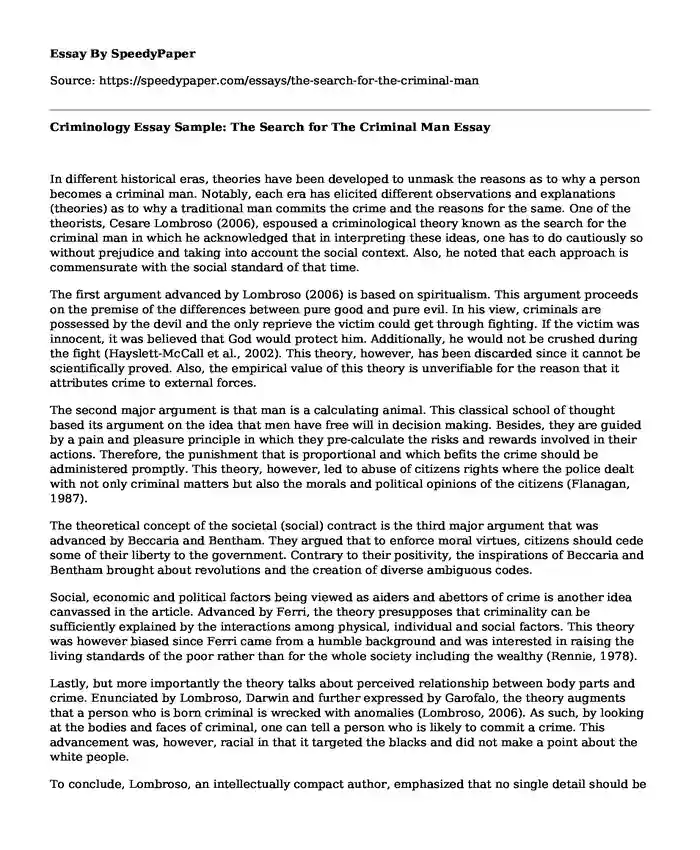
| Type of paper: | Essay |
| Categories: | Criminal law |
| Pages: | 3 |
| Wordcount: | 687 words |
In different historical eras, theories have been developed to unmask the reasons as to why a person becomes a criminal man. Notably, each era has elicited different observations and explanations (theories) as to why a traditional man commits the crime and the reasons for the same. One of the theorists, Cesare Lombroso (2006), espoused a criminological theory known as the search for the criminal man in which he acknowledged that in interpreting these ideas, one has to do cautiously so without prejudice and taking into account the social context. Also, he noted that each approach is commensurate with the social standard of that time.
The first argument advanced by Lombroso (2006) is based on spiritualism. This argument proceeds on the premise of the differences between pure good and pure evil. In his view, criminals are possessed by the devil and the only reprieve the victim could get through fighting. If the victim was innocent, it was believed that God would protect him. Additionally, he would not be crushed during the fight (Hayslett-McCall et al., 2002). This theory, however, has been discarded since it cannot be scientifically proved. Also, the empirical value of this theory is unverifiable for the reason that it attributes crime to external forces.
The second major argument is that man is a calculating animal. This classical school of thought based its argument on the idea that men have free will in decision making. Besides, they are guided by a pain and pleasure principle in which they pre-calculate the risks and rewards involved in their actions. Therefore, the punishment that is proportional and which befits the crime should be administered promptly. This theory, however, led to abuse of citizens rights where the police dealt with not only criminal matters but also the morals and political opinions of the citizens (Flanagan, 1987).
The theoretical concept of the societal (social) contract is the third major argument that was advanced by Beccaria and Bentham. They argued that to enforce moral virtues, citizens should cede some of their liberty to the government. Contrary to their positivity, the inspirations of Beccaria and Bentham brought about revolutions and the creation of diverse ambiguous codes.
Social, economic and political factors being viewed as aiders and abettors of crime is another idea canvassed in the article. Advanced by Ferri, the theory presupposes that criminality can be sufficiently explained by the interactions among physical, individual and social factors. This theory was however biased since Ferri came from a humble background and was interested in raising the living standards of the poor rather than for the whole society including the wealthy (Rennie, 1978).
Lastly, but more importantly the theory talks about perceived relationship between body parts and crime. Enunciated by Lombroso, Darwin and further expressed by Garofalo, the theory augments that a person who is born criminal is wrecked with anomalies (Lombroso, 2006). As such, by looking at the bodies and faces of criminal, one can tell a person who is likely to commit a crime. This advancement was, however, racial in that it targeted the blacks and did not make a point about the white people.
To conclude, Lombroso, an intellectually compact author, emphasized that no single detail should be overlooked when searching for the causes of criminal behavior. Furthermore, one must be impartial and strive to as much as possible be open minded. Every theory was constructed at a certain time and in a particular social context. As such, the different theories must be sparingly interpreted and applied lest they amount to an injustice. The main question to ask is; how have those past theories helped in determining the causes of criminal behavior today? Do the theories hold sway in the present social set up?
References
Flanagan, T. J. (1987). Change and influence in popular criminology: Public attributions of crime causation. Journal of Criminal Justice, 15(3), 231-243.
Hayslett-McCall, K. L., & Bernard, T. J. (2002). Attachment, masculinity, and self-control a theory of male crime rates. Theoretical Criminology, 6(1), 5-33.
Lombroso, C., Gibson, M., & Rafter, N. H. (2006). Criminal man. Duke University Press.
Rennie, Y. F. (1978). The search for criminal man: A conceptual history of the dangerous offender. Lexington, MA: Lexington Books.
Cite this page
Criminology Essay Sample: The Search for The Criminal Man. (2019, May 27). Retrieved from https://speedypaper.net/essays/the-search-for-the-criminal-man
Request Removal
If you are the original author of this essay and no longer wish to have it published on the SpeedyPaper website, please click below to request its removal:
- Research Paper Sample: Obesity Trends among Low-income Earners
- Free Essay on Pestle and Cage Analysis of Brazil
- Essay example: Suggestion Based on the Service Quality Management
- Essay Sample on the Expression of Pride
- Free Essay - The Importance of Australia's Bilateral Relationship with China
- Free Essay- Process of Public Offering Occurrence
- Essay Sample on Socratic Dialogue
Popular categories




